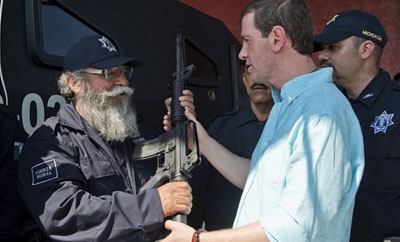Hundreds of vigilantes have joined Mexico’s new “Rural Defense Force” as part of a move to legalize self-defense militas, creating a potentially critical rift between militias prepared to be absorbed by the state and the many more that remain outside the law.
On May 11, the state of Michoacan’s security commissioner, Alfredo Castillo, officially launched the “State Rural Defense Force” with the creation of a 450-strong unit made up of members of the state’s self-defense militias, reported El Universal.
Among the first officers of the new force, which officials presented with arms, uniforms and vehicles, was the new official spokesperson for the General Council of Michoacan Self-Defense Forces, Estanislao Beltran, alias “Papa Smurf.”
Beltran told reporters, “We are legal now and we are committed to this, we are part of the government.”
The new force will begin operating in the municipalities of Tepalcatepec and Buena Vista Tomatlan, with the scheme slated to be later rolled out across the state.
Over 3,000 of an estimated 20,000 members of the self-defense militias applied to join the new force ahead of the registration deadline, although many did not pass exams or basic training.
Animal Politico reported that among the new recruits there was uncertainty over what their role was to be, and over other issues such as pay, benefits and working hours and conditions.
InSight Crime Analysis
The launch of the first Rural Defense Force marks the implementation of an agreement between vigilante groups and the government signed in Janaury this year.
The pact was an attempt by the government to get a grip on a situation that had rapidly spiraled out of control, and to strike a balance between helping citizens fight back against organized crime — which they claimed they were doing as a result of state failings — and preventing unchecked vigilante justice.
SEE ALSO: Mexico’s Security Dilema: Michoacan’s Militias
There are numerous obstacles facing the Rural Defense Force strategy in this regard, including the lack of clear definitions over members’ roles and relationship to state forces, and their long term place in regional security structures.
However, perhaps the greatest concern is the thousands of militiamen who remain outside the process. Some of these already work for militias believed to be linked to criminal groups, and even those that do not could be tempted to abuse or profit from their power, or work for criminal interests, now that they stand on the wrong side of the line drawn by the government.

